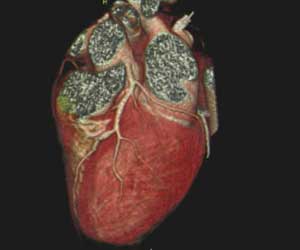- Home
- Editorial
- News
- Practice Guidelines
- Anesthesiology Guidelines
- Cancer Guidelines
- Cardiac Sciences Guidelines
- Critical Care Guidelines
- Dentistry Guidelines
- Dermatology Guidelines
- Diabetes and Endo Guidelines
- Diagnostics Guidelines
- ENT Guidelines
- Featured Practice Guidelines
- Gastroenterology Guidelines
- Geriatrics Guidelines
- Medicine Guidelines
- Nephrology Guidelines
- Neurosciences Guidelines
- Obs and Gynae Guidelines
- Ophthalmology Guidelines
- Orthopaedics Guidelines
- Paediatrics Guidelines
- Psychiatry Guidelines
- Pulmonology Guidelines
- Radiology Guidelines
- Surgery Guidelines
- Urology Guidelines
In which cases of CAD, accuracy of Coronary CT Angiography is highest, finds study

The accuracy of coronary computed tomography angiogram (CTA) is the highest for patients suspected with coronary heart disease if the probability of coronary artery disease(CAD) is between 7% to 67%, finds a new study. The study has been published in the BMJ.
Coronary CTA is an accurate non-invasive alternative to invasive coronary angiography and can rule out CAD with high certainty. A coronary computed tomography angiogram (CTA) uses advanced CT technology, along with intravenous (IV) contrast material (dye), to obtain high-resolution, 3D pictures of the moving heart and great vessels. But it remains unclear which patients might benefit the most from the procedure.
The study was designed to see whether coronary CTA should be performed in patients with any clinical probability of CAD and whether the diagnostic performance differs by patient subgroup. The study was a meta-analysis of individual patient data (n=5332) from 65 prospective diagnostic accuracy studies that compared coronary CTA with coronary angiography as the reference standard.
The lead authors Dr Robert Haase and Dr Marc Dewey from Charite - University Medicine Berlin in Germany found that "Our results indicate that the accuracy of coronary CTA is highest for clinical decision making if the probability of coronary disease is between 7% and 67%."
"Until now, guidelines recommend to consider CTA in stable chest pain either in all patients with angina pectoris (National Institute for Health and Care Excellence) or only those with 15-50% probability of coronary disease (European Society of Cardiology)," they explained.
According to the results of the study, at a pretest probability of 7%, the positive predictive value of coronary CTA was 50.9% and the negative predictive value was 97.8%. The corresponding values at a pretest probability of 67% were 82.7% and 85.0%. The overall sensitivity and specificity of coronary CTA were 95.2% and 79.2%, respectively.
"In this low-to-intermediate clinical probability range, coronary CTA was able to accurately stratify patients into those with a disease post-test probability of below 15%, in whom other reasons for the chest pain should be considered, and those with a probability above 50%, in whom further testing is recommended," write the researchers.
Coronary CTA using more than 64 detector rows was empirically more sensitive and specific than Cardiac computed tomography angiography (CCTA) using up to 64 detector rows, "indicating that recent CTA technology with more than 64 rows should be used," they note.
For Further reference log on to :
https://doi.org/10.1136/bmj.

Disclaimer: This site is primarily intended for healthcare professionals. Any content/information on this website does not replace the advice of medical and/or health professionals and should not be construed as medical/diagnostic advice/endorsement or prescription. Use of this site is subject to our terms of use, privacy policy, advertisement policy. © 2020 Minerva Medical Treatment Pvt Ltd